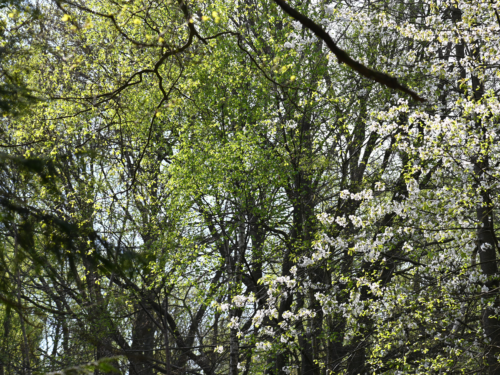A defiant lone hawthorn guarding the Scottish coastline is the winner of the Woodland Trust’s Tree of The Year for 2021.
The tree at Kippford, Dalbeattie in Dumfries & Galloway is a fine example of a native, mature tree and while not spectacular in size, it cuts a striking presence as the only tree on the windswept cockle shell beach.
Now in its seventh year, the Woodland Trust’s Tree of The Year contest highlights the UK’s favourite trees to help show their value and need for protection.
The hawthorn took 38% of the vote, finishing above a Monterey cypress tree planted on a beach in Saundersfoot, Pembrokeshire, Wales (19%) that was saved from felling this year after a passionate public campaign.
In third place with 13% was an exceptional parasol beech in Parkanaur Forest Park, County Tyrone, Northern Ireland – a rare specimen with knotted branches growing randomly back towards the ground.
The competition was held across social media, with a shortlist of 10 finalists selected from hundreds of nominations across The Woodland Trust’s Facebook, Twitter and Instagram accounts using #TreeoftheWeek
Tree surgeon Drew Patterson, who nominated the winning hawthorn, was thrilled to see such a ‘beautiful specimen’ take the coveted prize.
“I love this tree, it’s amazing,” said Drew, 57, whose father, grandfather and great grandfather all came from Dalbeattie.
“It is a superb hawthorn and it’s incredible it has survived this well having been climbed on, battered by the winds and even bumped into by cars turning.
“It’s in a wild place and has been blown over at an angle, but it is still standing strong and proud on the edge of the beach.
“It has been there as long as I can remember and I have so many fond memories going back through the generations. I have pictures of my grandfather and mum in front of the tree.
“It is at least 60 years and could be as many as 100. Seeing the tree win this award is special.”
Adam Cormack, head of campaigning for the Woodland Trust, said the tree – which is also known as the ‘Kippford Leaning Tree’ – is a worthy winner.
He said: “We’ve had winners of all shapes and sizes in previous years and this is a tree that stands out for different reasons, notably because of its striking presence in an unusual setting.
“It is also a special tree for Drew because of the family significance, which highlights the importance individual trees can have. Lots of trees are equally meaningful to someone, providing a connection and treasured memories.”
The winning hawthorn tree will now go on to represent the UK in the European Tree of the Year 2022 contest.
The Woodland Trust’s Tree of The Year competition aims to highlight how vital trees are for our landscapes and our lives. Trees are essential in the fight against the climate and nature crisis we are facing, yet many of the UK’s oldest and most valuable trees have no form of legal protection.
Tree of the Year finalists
1. Beech – Silent Valley, Ebbw Vale, Gwent, Wales
This magnificent beech is a prime example of a mature tree within a woodland – a key feature of woods in good ecological condition. It has spectacular exposed roots that are covered in moss and gnarled bark full of character and weathered over time.
2. Hawthorn – Kippford, Dalbeattie, Dumfries & Galloway, Scotland (1st – 38%)
A lonesome but fiercely proud hawthorn still managing to guard the coastline despite being battered by the elements is a fine example of a mature tree. And while not spectacular in size it cuts a striking presence in an unusual setting and is equally as important as more imposing specimens.
3. Monterey cypress – Saundersfoot, Pembrokeshire, Wales (2nd – 19%)
An iconic Monterey cypress tree planted on the beach in 1938. Known locally as ‘Saundersfoot’s Eiffel Tower’, it was saved from felling this year after a passionate public campaign.
4. Ash – Ettrick Forest, Selkirk, Scotland
A tree that is almost certainly a descendant of the Ettrick Forest sitting in majestic surroundings within a churchyard. Steeped in history and cultural value, this delightful ash tree is a defiant reminder of the need to deal with the threat of exotic tree diseases like ash dieback.
5. Hornbeam – Ashenbank Wood, Cobham, Kent, England
The Teapot Tree beautifully describes this stunningly simple hornbeam’s posture, while its bark is truly eye-catching and so full of personality. It’s a wonderful example of a veteran tree that benefits from basic conservation measures – a simple fence made from sustainable materials to keep it protected in a highly visited area.
6. Sweet chestnut – Rydal, Cumbria, England
A famous much-celebrated ‘monster’ of a sweet chestnut tree. It is over 600 years old and as well as its remarkable stature and imposing branches, its twisting trunk makes it a sight to behold.
7. Parasol beech – Parkanaur Forest Park, County Tyrone, Northern Ireland (3rd – 13%)
An exceptional curly beech with rare features, this tree captivated the judges. Unusually low in appearance for its species, the knotted branches grow randomly back towards the ground to add further charm.
8. Oak tree – Helions Bumpstead, Braintree, Essex, England
Not the mightiest oak but bundles of personality and a perfect example of how oaks can host other species such as moss and ivy cascading from its trunk and branches. These coexist and do no damage to its ecosystem. This oak looks simply splendid captured in all its autumn glory.
9. Sweet chestnut – Willesley Park Golf Club, Ashby-de-la-Zouch, Leics, England (5th – 7%)
A gargantuan tree with a girth of more than 11 metres in a very different setting. The sheer size and wow factor makes it a standout entry.
10. Sycamore – Newark, Nottinghamshire, England (4th – 11%)
A much-loved mature sycamore saved by the community in Newark, who stopped the chop for a car park. All the hard campaigning shows the power of peaceful protests – and thankfully this glorious specimen will continue to be part of the community for years to come.
 https://www.maelor.co.uk/wp-content/uploads/2024/05/Property-Photos-3-500x295.png
https://www.maelor.co.uk/wp-content/uploads/2024/05/Property-Photos-3-500x295.png






